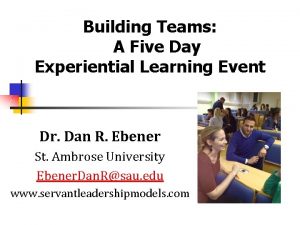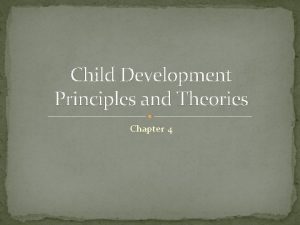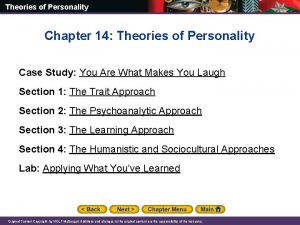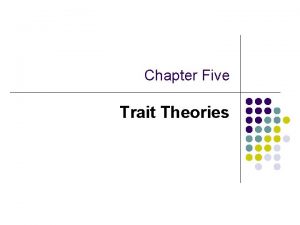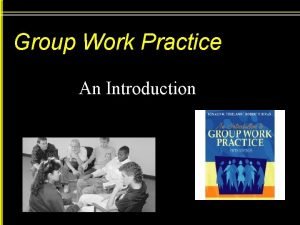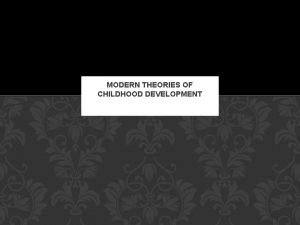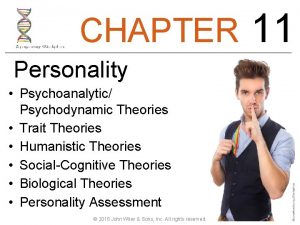Chapter 4 Group Work Theories and Applications Introduction

























- Slides: 25

Chapter 4: Group Work: Theories and Applications Introduction to Group Work, 5 th Edition Edited by David Capuzzi, Douglas R. Gross, and Mark D. Stauffer

Adlerian Theory/ Alfred Adler l Major concepts Humanistic: individual/society valued over the organization Holistic: individual is indivisible Phenomenological: focus on individual’s perspective Teleological: future orientation, goal attainment Field theoretical: interaction of social and physical environment Socially oriented: contribution to society Operational: methodology Introduction to Group Work, 5 th Edition Edited by: David Capuzzi, Douglas R. Gross, and Mark. D. Stauffer

Adlerian Theory/ Alfred Adler l Motivating forces influencing goals Fictional goals Birth order The family constellation Style of life Introduction to Group Work, 5 th Edition Edited by: David Capuzzi, Douglas R. Gross, and Mark. D. Stauffer

Adlerian Theory/ Alfred Adler l Leader Behaviors Establish working relationship and member equality. Serve as models for members. Communicate mutual trust, respect. Help members to: Explore goals, beliefs, feelings, motives Increase insight (fictitious goals, self-defeating behaviors) Accept responsibility Consider alternative lifestyles Enhance social interest Accept self Develop sense of community Explore alternative behaviors Introduction to Group Work, 5 th Edition Edited by: David Capuzzi, Douglas R. Gross, and Mark. D. Stauffer

Adlerian Theory/ Alfred Adler l Group stages Develop therapeutic relationship. Assess the dynamics that operate within individuals. Aid the individual to gain insight and selfunderstanding. Assist the individual to discover alternatives and new choices. Introduction to Group Work, 5 th Edition Edited by: David Capuzzi, Douglas R. Gross, and Mark. D. Stauffer

Gestalt Theory/ Fritz Perls l Major concepts Holistic Field: figure and background Individual responsibility Phenomenological Existential Five layers of neurosis: Cliché, Phony, Impasse, Implosive, Explosive Open-ended approach Individual strives toward equilibrium Introduction to Group Work, 5 th Edition Edited by: David Capuzzi, Douglas R. Gross, and Mark. D. Stauffer

Gestalt Theory/ Fritz Perls l Leader Behaviors Establish environment: Leader/members share equally in process of change Supportive, compassionate, accepting, challenging Allow members to find own way in life. Here-and-now focus. Recognize members’ blocks and boundaries. Aid members in accepting all aspects of selves. Confront defensive structures. Address unfinished business. Help members try new behaviors and recognize splintered parts of self. Introduction to Group Work, 5 th Edition Edited by: David Capuzzi, Douglas R. Gross, and Mark. D. Stauffer

Gestalt Theory/ Fritz Perls l Group stages through the group leader (Gestalt therapy does not lend itself well to stages) Help members become actively involved. Demonstrate the meanings of gesture, posture, and movement in communication. Conduct experiments. Demonstrate the ability to stay in the here and now. Apply active listening skills. Introduction to Group Work, 5 th Edition Edited by: David Capuzzi, Douglas R. Gross, and Mark. D. Stauffer

Gestalt Theory/ Fritz Perls l Group stages through the group leader, continued Help members provide feedback. Model interpersonal interactions. Use confrontation to shock members into greater awareness of their self-defeating behaviors. Be a creative agent of change. Observe and give feedback on members’ nonverbal behaviors. Introduction to Group Work, 5 th Edition Edited by: David Capuzzi, Douglas R. Gross, and Mark. D. Stauffer

Person-Centered Theory/ Carl Rogers l Major concepts Phenomenological Holistic Has an optimistic view of human potential The need for positive regard Conditions of worth Congruence/genuineness Empathy Introduction to Group Work, 5 th Edition Edited by: David Capuzzi, Douglas R. Gross, and Mark. D. Stauffer

Person-Centered Theory/ Carl Rogers l Core conditions: Necessary and sufficient to bring about change Psychological contact Incongruence Congruence/genuineness Unconditional positive regard Empathy Introduction to Group Work, 5 th Edition Edited by: David Capuzzi, Douglas R. Gross, and Mark. D. Stauffer

Person-Centered Theory/ Carl Rogers l Leader Behaviors Establish facilitative climate (congruence, unconditional positive regard, empathic understanding). Provide safety and trust. Leader and members share equally in change. Be congruent (genuine) in relationships. Have unconditional positive regard. Have empathic understanding. Support members finding own way in life. Refrain from giving advice. Use one’s being as a catalyst for change. Introduction to Group Work, 5 th Edition Edited by: David Capuzzi, Douglas R. Gross, and Mark. D. Stauffer

Person-Centered Theory/ Carl Rogers l Group stages (There are no steps, stages, techniques, or tools—only core conditions) Silence as a way of communicating Active listening Confrontation Attending behaviors Empathic understanding Self-disclosure Self-empowerment Introduction to Group Work, 5 th Edition Edited by: David Capuzzi, Douglas R. Gross, and Mark. D. Stauffer

Rational–Emotive Behavior Therapy/Albert Ellis l Major concepts A–B–C–D–E Model Activating event Belief Consequence Disputing Effect Irrational patterns of thinking Actualizing potential of the individual Counselor is active, didactic, and confrontive and leads client to more rational ways of thinking and behavior. Introduction to Group Work, 5 th Edition Edited by: David Capuzzi, Douglas R. Gross, and Mark. D. Stauffer

Rational–Emotive Behavior Therapy/Albert Ellis l Leader Behaviors Genuine, instructional, didactic, accepting, confrontational, challenging Teach members about faulty thinking Separate behavior from personhood Set aside own need for personal relationship with group Detect and confront members with irrational beliefs Dispute “crooked” thinking of members Teach principles of REBT (A-B-C-D-E model) Provide homework Use contingency management and skill training Introduction to Group Work, 5 th Edition Edited by: David Capuzzi, Douglas R. Gross, and Mark. D. Stauffer

Rational–Emotive Behavior Therapy/Albert Ellis l Group stages (not presented in stages but in levels of perspectives) Cognitive–explicatory Evocative–emotive Behavioristic–active–directive Introduction to Group Work, 5 th Edition Edited by: David Capuzzi, Douglas R. Gross, and Mark. D. Stauffer

Transactional Analysis/ Eric Berne l Major concepts Designed specifically for groups Life scripts and rescripting Individual autonomy Redecisional model Ego states (parent, adult, and child) Strokes Life positions Introduction to Group Work, 5 th Edition Edited by: David Capuzzi, Douglas R. Gross, and Mark. D. Stauffer

Transactional Analysis/ Eric Berne l Leader Behaviors Develop therapeutic contract. Instruct members in terminology of TA. Analyze at least 4 elements in group’s communications: structures, transactions, games, scripts. Establish working partnership. Enhance awareness of scripts. Provide positive strokes. Reinforce the redecisions. Function in cognitive and rational domain. Challenge members to change thinking, feeling, behaving. Enhance autonomy to reduce dependence on group. Introduction to Group Work, 5 th Edition Edited by: David Capuzzi, Douglas R. Gross, and Mark. D. Stauffer

Transactional Analysis/ Eric Berne l Group examples (stages are not specified) Establishing a facilitative climate Providing instruction in TA concepts Developing contracts that identify goals Working through various analyses of group members’ structures, transactions, games, and scripts Terminating with specific directives for actionoriented change Introduction to Group Work, 5 th Edition Edited by: David Capuzzi, Douglas R. Gross, and Mark. D. Stauffer

Psychodrama/ Jacob L. Moreno l Major concepts A group member acts out his or her problem Preaction, and integration Role theory and role playing Catharsis Insight Introduction to Group Work, 5 th Edition Edited by: David Capuzzi, Douglas R. Gross, and Mark. D. Stauffer

Psychodrama/ Jacob L. Moreno l Leader Behaviors Establish relationship based on equality. Develop trust and spontaneity among members. Establish acceptance and tolerance of change. Establish format that allows members to work on significant life issues. Encourage risk in playing out psychodrama. Provide protection from abuse. Utilize creativity as a model for members. Utilize knowledge and skill in directing psychodramatic enactment. Introduction to Group Work, 5 th Edition Edited by: David Capuzzi, Douglas R. Gross, and Mark. D. Stauffer

Psychodrama/ Jacob L. Moreno l Group stages Member scripts out a situation Preaction (warm-up) Action Integration (feedback, discussion, and closure) Introduction to Group Work, 5 th Edition Edited by: David Capuzzi, Douglas R. Gross, and Mark. D. Stauffer

An Integration of Theoretical Approaches l Relationship variables A working relationship is basic to all six. l Leader role variables Leader is active in all six theoretical orientations. l Member role variables Group members play an active role. Introduction to Group Work, 5 th Edition Edited by: David Capuzzi, Douglas R. Gross, and Mark. D. Stauffer

An Integration of Theoretical Approaches l Process variables This area has the most variability among all six approaches. l Outcome variables This area has the greatest similarities among the six approaches. Introduction to Group Work, 5 th Edition Edited by: David Capuzzi, Douglas R. Gross, and Mark. D. Stauffer

An Integration of Theoretical Approaches l Implementation Be familiar with all theoretical approaches. Attempt to integrate various approaches in working with groups. Apply theoretical approaches as they were intended to be used. Do not rely solely on one approach to the exclusion of others. Experiment with many approaches until you find the combinations that fit your personal philosophy. Introduction to Group Work, 5 th Edition Edited by: David Capuzzi, Douglas R. Gross, and Mark. D. Stauffer
 Colour design: theories and applications
Colour design: theories and applications Chapter 4 section 1 work and machines answer key
Chapter 4 section 1 work and machines answer key Remedial model of social work
Remedial model of social work Team vs group
Team vs group Smart work vs hard work group discussion
Smart work vs hard work group discussion Brown and clough theory on group living
Brown and clough theory on group living Small group communication theories
Small group communication theories Theories for direct social work practice
Theories for direct social work practice An introduction to theories of learning
An introduction to theories of learning Classification of nursing theories
Classification of nursing theories Child development chapter 4
Child development chapter 4 Chapter 6 - theories of international trade and investment
Chapter 6 - theories of international trade and investment Contoh group technology
Contoh group technology Management myths in software engineering
Management myths in software engineering Anova within group and between group
Anova within group and between group Classification of social group
Classification of social group Amino group and carboxyl group
Amino group and carboxyl group Amino group and carboxyl group
Amino group and carboxyl group Imt group 2 specialties
Imt group 2 specialties Joining together group theory and group skills
Joining together group theory and group skills Skills and applications chapter 3
Skills and applications chapter 3 Vehicle maneuvers
Vehicle maneuvers Chapter 28 unemployment
Chapter 28 unemployment The life skill using community resources means
The life skill using community resources means Chapter 14 theories of personality worksheet answers
Chapter 14 theories of personality worksheet answers Theories of mineralization
Theories of mineralization



